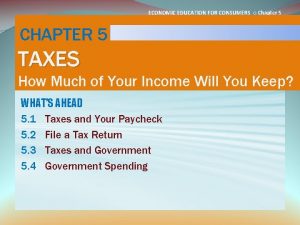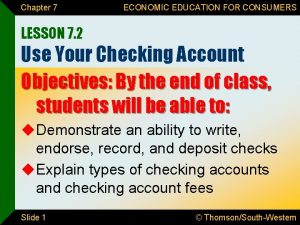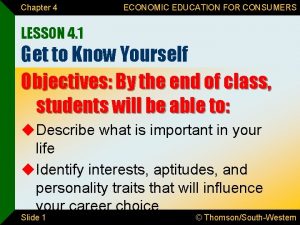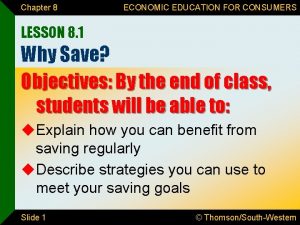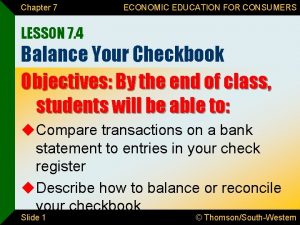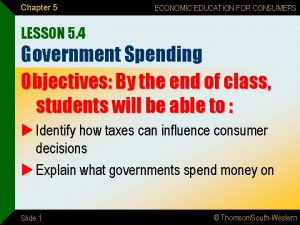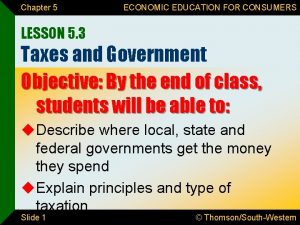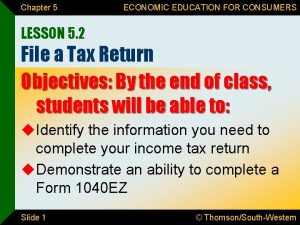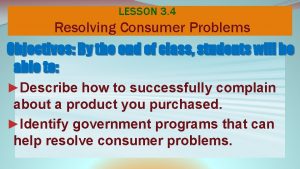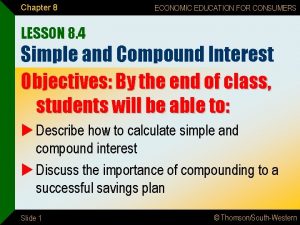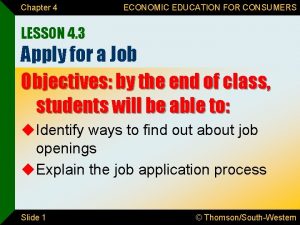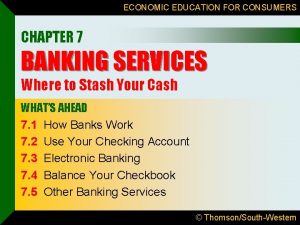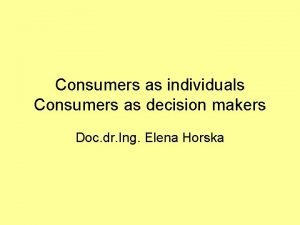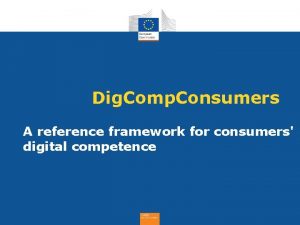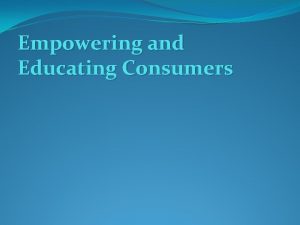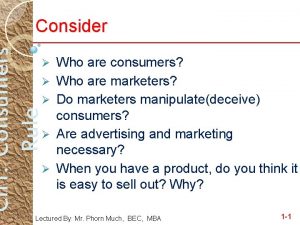ECONOMIC EDUCATION FOR CONSUMERS Chapter 10 CHAPTER 10


































- Slides: 34

ECONOMIC EDUCATION FOR CONSUMERS ○ Chapter 10 CHAPTER 10 CREDIT You’re in Charge WHAT’S AHEAD 10. 1 What Is Credit? 10. 2 How to Qualify for Credit 10. 3 Sources of Consumer Credit 10. 4 Credit Rights and Responsibilities 10. 5 Maintain a Good Credit Rating

ECONOMIC EDUCATION FOR CONSUMERS ○ Chapter 10 LESSON 10. 1 What Is Credit? GOALS ►Identify reasons to borrow and the trade-offs you make when you borrow. ►Discuss how to plan when and how much to borrow. Slide 2 © 2010 South-Western, Cengage Learning

ECONOMIC EDUCATION FOR CONSUMERS ○ Chapter 10 KEY TERMS § credit § Equity § Credit Video: § http: //www. youtube. com/watch? v=83 wty. Eq. D 1 fc § Funny Money Credit Video Slide 3 © 2010 South-Western, Cengage Learning

ECONOMIC EDUCATION FOR CONSUMERS ○ Chapter 10 Consumer Action ►Ryan lives at home with parents. His take-home pay from a part time job is $1, 700 a month. He gives his parents $300 each month to help out with expenses. He would like to buy a new car that he saw at a local dealership. To buy it, he would have to get a loan with payments of $400 a month. He really wants the car. ►Should he buy it? Slide 4 © 2010 South-Western, Cengage Learning

ECONOMIC EDUCATION FOR CONSUMERS ○ Chapter 10 What is Credit? ►The ability to borrow money in return for a promise of future payment is credit. ►Future repayment usually includes interest. ► Example: Suppose you use credit to buy a jacket for $100. If your interest rate is 15% per year, you must repay $115 at the end of the year. ► 100 X. 15 =$15 ► 100 + 15 = 115 ►You give up future spending for the ability to purchase now. Slide 5 © 2010 South-Western, Cengage Learning

ECONOMIC EDUCATION FOR CONSUMERS ○ Chapter 10 Why Borrow? ►For your goals ►For a home ►A home as an investment ►Equity: The difference between the amount owed on a home and the homes' value. ►Taxes and homeownership ►For your education ►Student-loan borrowers average debt in 2015 was $30, 100 ►For your health Slide 6 © 2010 South-Western, Cengage Learning

ECONOMIC EDUCATION FOR CONSUMERS ○ Chapter 10 Plan Your Borrowing ►When to borrow ►Is it important that I buy the good or service I want now? ►Do I have to borrow to buy the product? ►Can I afford to make the payments on the loan ►Will I be able to buy other products I want more if I borrow to buy this product? ►How much to borrow ►Basic rule to borrowing is that your total debt payments (excluding housing costs) should be no more than 20 to 25 percent of your net pay ► Slide 7 Example: If you make $500/month your total debt payment should be no more than $125/month ► 500 X. 25 = $125 © 2010 South-Western, Cengage Learning

ECONOMIC EDUCATION FOR CONSUMERS ○ Chapter 10 LESSON 10. 2 How to Qualify for Credit GOALS ►Explain how lenders judge your creditworthiness. ►Describe the factors that determine your credit rating. Slide 8 © 2010 South-Western, Cengage Learning

ECONOMIC EDUCATION FOR CONSUMERS ○ Chapter 10 KEY TERMS § § § § Slide 9 creditworthiness character credit history cosign capacity capital credit bureau credit rating © 2010 South-Western, Cengage Learning

ECONOMIC EDUCATION FOR CONSUMERS ○ Chapter 10 Your Creditworthiness ►Creditworthiness is a measure of your reliability to repay a loan ►How you can establish creditworthiness ►Find and keep a job with steady income, either part-time or full-time ►Establish a checking and savings account at a financial institution. Do not overdraw your accounts ►Apply for a credit card through a local bank or institution. Charge only what you can afford and pay it off on a monthly basis ►Apply for a loan and make all payments in full and on time. Slide 10 © 2010 South-Western, Cengage Learning

ECONOMIC EDUCATION FOR CONSUMERS ○ Chapter 10 Your Creditworthiness ►The Three C’s of Credit ►Character ►A measure of your financial responsibility ► Credit History: A record of your past borrowing and repayments ►Capacity ► A measure of your financial ability to repay a loan ►Capital ► The value of what you own (assets) including savings, investments and property Slide 11 © 2010 South-Western, Cengage Learning

ECONOMIC EDUCATION FOR CONSUMERS ○ Chapter 10 Your Credit Rating ►Loan applications ►Credit bureaus ►A company that collects information such as your borrowing and repayment history and sells it to lenders. ►Three largest credit bureau companies ► Experian, Transunion, Equifax ►Credit ratings ►Fair Isaac Corporation, which created the most widely used scale referred to as FICO® scores. ►Between 300 and 850 (Best) Slide 12 © 2010 South-Western, Cengage Learning

ECONOMIC EDUCATION FOR CONSUMERS ○ Chapter 10 Credit Rating Factors Book Pg. 334 Payment history Current debt Length of credit history New accounts and inquiries § Types of credit used § § Slide 13 Weighting of factors that affect FICO® credit scores © 2010 South-Western, Cengage Learning

ECONOMIC EDUCATION FOR CONSUMERS ○ Chapter 10 10. 2 REVIEW ØWhat are three C’s of credit? Ø Character Ø Capacity Ø Capital ØWhat is a credit rating? Ø A measure of your creditworthiness ØWhat kinds of information is a credit bureau collecting about you? Ø Your past borrowing Ø Your repayment history Slide 14 © 2010 South-Western, Cengage Learning

ECONOMIC EDUCATION FOR CONSUMERS ○ Chapter 10 LESSON 10. 3 Sources of Consumer Credit GOALS ►Explain differences between a secured an unsecured loan. ►Describe benefits and costs of using credit cards. Slide 15 © 2010 South-Western, Cengage Learning

ECONOMIC EDUCATION FOR CONSUMERS ○ Chapter 10 KEY TERMS § § Slide 16 secured loan collateral installment loan unsecured loan § § regular charge account revolving charge account grace period credit limit © 2010 South-Western, Cengage Learning

ECONOMIC EDUCATION FOR CONSUMERS ○ Chapter 10 Types of Consumer Borrowing Loans (Close Ended) § You receive an amount of money all at once to make your purchase § Specific payments to repay the loan with interest by a certain date Slide 17 Credit Card Accounts (Open Ended ) § The amount of your purchase is added to your account § Pay at least the minimum payment each month § No specific payoff date © 2010 South-Western, Cengage Learning

ECONOMIC EDUCATION FOR CONSUMERS ○ Chapter 10 Consumer Loans ►Secured loan ►Backed by something of value pledged to ensure payment ► Example: Home loans ►The property pledged to back a loan is called Collateral ►Installment loan ► Repaid in a certain number of payments with a fixed interest rate for the term of the loan ► Example: Vehicle Loans ►Unsecured loan ►Not backed by collateral ►Based on your creditworthiness alone ►Usually higher interest rates Slide 18 © 2010 South-Western, Cengage Learning

ECONOMIC EDUCATION FOR CONSUMERS ○ Chapter 10 Sources of Loans ►Banking institutions ►Banks, savings and loan associations and credit unions ►Other sources of consumer loans ►Finance companies ►Payday loans ►Life insurance companies Book Pgs. ►Credit card cash advances 337 -338 ►Pawnbrokers ►Rent-to-own companies Slide 19 © 2010 South-Western, Cengage Learning

ECONOMIC EDUCATION FOR CONSUMERS ○ Chapter 10 Credit Cards ►Regular charge accounts ►Account balance must be paid in full each month ►No stated interest rate ►American Express, Diner’s Club, some department stores ►Revolving charge accounts ►Allows you to carry a balance from one month to the next. ►Pay interest on the account balance ►Sources of credit cards ►Visa, Master. Card, American Express, Discover ►Charities, gas companies, universities, credit unions, ►Credit card incentives ►Example: Free gas, airline miles etc. Slide 20 © 2010 South-Western, Cengage Learning

ECONOMIC EDUCATION FOR CONSUMERS ○ Chapter 10 Did you know? ? ►The first widely accepted plastic charge card was issued in 1958 by American Express. ►Average credit card debt per household with credit card debt: $15, 799* ►Each American household receives approximately 6 credit card offers a month. The typical response rate is. 33% (one third of one percent). ►Total U. S. consumer debt: $2. 5 trillion, as of December 2011 ►The average at which a U. S. consumer under the age of 35 first adopted a credit card is 20. 8 years Slide 21 © 2010 South-Western, Cengage Learning

ECONOMIC EDUCATION FOR CONSUMERS ○ Chapter 10 Credit Card Costs ►Annual fees ►$15 to $100 ►Many cards do not have annual fees ►Interest ►Credit Card Balance Calculator ►Grace period- the time between the billing date and the payment due date when no interest is charged. ►Limits and penalties ►Credit limit-the maximum amount you are allowed to charge ►Fees if you go over your credit limit Slide 22 © 2010 South-Western, Cengage Learning

ECONOMIC EDUCATION FOR CONSUMERS ○ Chapter 10 Control Credit Card Costs ►A loan as an alternative ►The minimum payment trap ►Choose the least expensive card Slide 23 © 2010 South-Western, Cengage Learning

ECONOMIC EDUCATION FOR CONSUMERS ○ Chapter 10 LESSON 10. 4 Credit Rights and Responsibilities GOALS ►Discuss ways that laws protect your credit rights. ►Describe how to take responsibility for your own financial health. Slide 24 © 2010 South-Western, Cengage Learning

ECONOMIC EDUCATION FOR CONSUMERS ○ Chapter 10 KEY TERMS § finance charge § annual percentage rate (APR) Slide 25 © 2010 South-Western, Cengage Learning

ECONOMIC EDUCATION FOR CONSUMERS ○ Chapter 10 Consumer Credit Rights ►Truth in lending ►Truth in Lending Act of 1968 ► Requires all banks to calculate credit costs the same way ► Provide the finance charge and annual percentage rate ► Finance charge: the total cost a borrower must pay for a loan, including interest and fees ► Annual percentage rate: the finance charge calculated as a percentage of the amount borrowed ►Equality in lending ►Equal Credit Opportunity Act of 1975 ► Made it illegal to refuse credit based on the basis of race, color, religion, national origin, gender, marital status or age. Slide 26 © 2010 South-Western, Cengage Learning

ECONOMIC EDUCATION FOR CONSUMERS ○ Chapter 10 Consumer Credit Rights ►Protect your credit history ►Fair Credit Reporting Act of 1971 ► Requires lending organizations to identify the credit bureau that supplied information used in lending decisions ► Allows people who are refused credit 30 days to request a free copy of their credit report ► Requires credit bureaus to give consumers one free copy of their credit report a year. Slide 27 © 2010 South-Western, Cengage Learning

ECONOMIC EDUCATION FOR CONSUMERS ○ Chapter 10 Consumer Credit Rights ►Act if you are refused credit pg. 346 ►Resolve billing and product quality problems ►Within 60 days write to company that issued your card ►Company must reply within 30 days and resolve the dispute within 90 ►Protection from abusive collection practices ►Fair Debt Collection Act of 1977 ►A debt collector may not: ► Call before 8 am ► Call after 9 pm ► Call your place of work if they are aware that your employer doesn’t approve ► Lie or harass you ► Ignore a written request to a stop contact Slide 28 © 2010 South-Western, Cengage Learning

ECONOMIC EDUCATION FOR CONSUMERS ○ Chapter 10 Consumer Credit Responsibilities ►Accept responsibility ►Know your debt capacity ►Take Home pay –Fixed expenses (rent , insurance)- Other expenses (food, gas, etc) = What's left? ►Credit and family ►Self-control with credit ►Pay more than the minimum ►Avoid too many credit cards ►Pay cash ►Keep accurate records Slide 29 © 2010 South-Western, Cengage Learning

ECONOMIC EDUCATION FOR CONSUMERS ○ Chapter 10 LESSON 10. 5 Maintain a Good Credit Rating GOALS ►Explain how to establish a positive credit history. ►Discuss how to avoid credit problems and get help if you need it. Slide 30 © 2010 South-Western, Cengage Learning

ECONOMIC EDUCATION FOR CONSUMERS ○ Chapter 10 KEY TERMS § identity theft § debt consolidation loan § bankruptcy Slide 31 © 2010 South-Western, Cengage Learning

ECONOMIC EDUCATION FOR CONSUMERS ○ Chapter 10 Establish Your Credit History ►Start small ►Never miss a payment ►Save Regularly ►Charge small amounts and pay them off immediately ►Establish your own credit ►Avoid common credit mistakes ►Read what you sign ►Be aware of identity theft ►Identity theft: using someone else’s identity to get cash or buy products using credit, or to access financial accounts that belong to the victim. ► Slide 32 Businesses are responsible for debts, but records of the transactions can ruin your credit history! © 2010 South-Western, Cengage Learning

ECONOMIC EDUCATION FOR CONSUMERS ○ Chapter 10 Identity Theft ►How “They” Become “You” ►Social security #, Driver’s license # or Credit Card # ►How to protect yourself ►Never give out your Social Security number unless absolutely necessary ►What to do if you identity is stolen ►Call the 3 major reporting agencies – Equifax, Experian, & Trans Union. ► ► Slide 33 Have them to put a fraud alert on your file and ask that they call you before any new accounts are opened or existing accounts are changed Report theft to law enforcement agencies Contact your bank or other organizations that have extended you credit Call the Federal Trade Commission (FTC) ID hotline or visit the FTC’s website. © 2010 South-Western, Cengage Learning

ECONOMIC EDUCATION FOR CONSUMERS ○ Chapter 10 Help for Credit Problems ►Debt consolidation loans ►Designed to pay off all the smaller loans and give you one payment to make each month ►Cost of a debt consolidation loan ► Lower monthly payment, but you pay more in interest ►It’s a bandage, not a cure ►Credit counseling services ►Bankruptcy ►A legal process in which people who cannot pay their debts must surrender most of their property. ►Stays on your credit report for 10 years. Slide 34 © 2010 South-Western, Cengage Learning
 Alligator food chain
Alligator food chain Primary producers
Primary producers Producers respond to consumers' positive economic votes by
Producers respond to consumers' positive economic votes by Economic growth vs economic development
Economic growth vs economic development Economic development vs economic growth
Economic development vs economic growth Lesson 2 our economic choices
Lesson 2 our economic choices Fspos
Fspos Novell typiska drag
Novell typiska drag Nationell inriktning för artificiell intelligens
Nationell inriktning för artificiell intelligens Vad står k.r.å.k.a.n för
Vad står k.r.å.k.a.n för Varför kallas perioden 1918-1939 för mellankrigstiden
Varför kallas perioden 1918-1939 för mellankrigstiden En lathund för arbete med kontinuitetshantering
En lathund för arbete med kontinuitetshantering Kassaregister ideell förening
Kassaregister ideell förening Personlig tidbok fylla i
Personlig tidbok fylla i A gastrica
A gastrica Förklara densitet för barn
Förklara densitet för barn Datorkunskap för nybörjare
Datorkunskap för nybörjare Boverket ka
Boverket ka Mall för debattartikel
Mall för debattartikel Delegerande ledarstil
Delegerande ledarstil Nyckelkompetenser för livslångt lärande
Nyckelkompetenser för livslångt lärande Påbyggnader för flakfordon
Påbyggnader för flakfordon Kraft per area
Kraft per area Svenskt ramverk för digital samverkan
Svenskt ramverk för digital samverkan Urban torhamn
Urban torhamn Presentera för publik crossboss
Presentera för publik crossboss Argument för teckenspråk som minoritetsspråk
Argument för teckenspråk som minoritetsspråk Kanaans land
Kanaans land Treserva lathund
Treserva lathund Mjälthilus
Mjälthilus Bästa kameran för astrofoto
Bästa kameran för astrofoto Cks
Cks Programskede byggprocessen
Programskede byggprocessen Bra mat för unga idrottare
Bra mat för unga idrottare Verktyg för automatisering av utbetalningar
Verktyg för automatisering av utbetalningar




































